PDF chapter test TRY NOW
Transpiration:
It is a process that is similar to evaporation, as it is the loss of water in the form of vapour.
As we learnt above, all the plants, from small shrubs to tall trees, require water to perform photosynthesis. This water is absorbed by the roots (root hairs) of the plants through the process of osmosis. But from the total amount of water absorbed, only a small percentage of water is used by the plants. The rest gets evaporated from the leaves. This evaporation of water is known as transpiration.
The loss of water in the form of water vapour from the aerial parts of the plant body is known as transpiration.
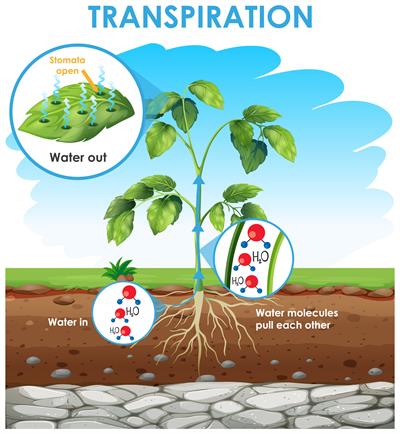
Transpiration
The leaves of green plants have tiny, microscopic pores known as stomata. The water content in the plants evaporates through these stomata.
Structure of stomata:
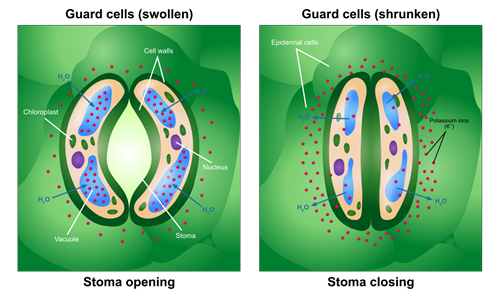
Stomata open and close
Each stomatal pore is surrounded by two kidney-shaped cells known as guard cells that help in regulating the rate of transpiration by opening and closing of stomata.
Let us understand the process of transpiration more clearly by the following experiment.
- Take a well-watered potted plant and cover it with a plastic bag by tying its mouth at the base of the stem.
- Next to this plant, place an empty plastic bag and tie its mouth.
- Expose both the plant and the empty plastic bag to the sun and observe.
Observation:
- After some time, we can see water droplets getting collected due to the condensation of water vapour inside the bag which covers the plant.
- Inside the empty plastic bag, there are no water droplets.
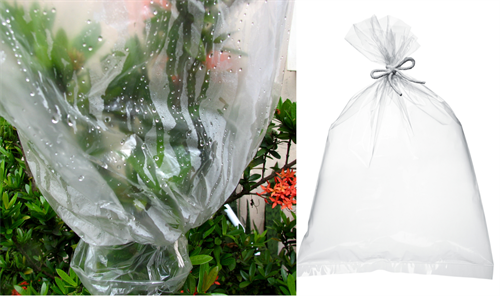
Conclusion:
From this above experiment, we can conclude that transpiration occurs in plants to eliminate the excess water.
Types of transpiration:
Transpiration is of three types based on the site where they occur. They are as follows:
- Stomatal transpiration
- Lenticular transpiration
- Cuticular transpiration
1. Stomatal transpiration:
The loss of water from the plants through stomata is known as stomatal transpiration. 90-95% of the water that is transpired from the leaves occurs through the stomata.
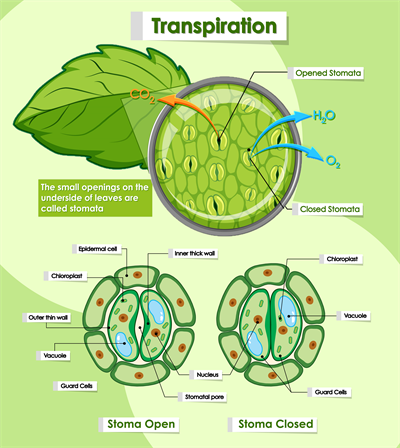
Stomatal transpiration
2. Lenticular transpiration:
What are lenticels?
The tiny openings that protrude from the barks in woody stems and twigs and other plant organs are known as lenticels.
When compared to the stomata, lenticels are less in number.
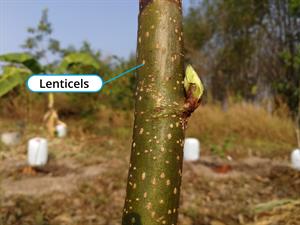
Lenticular transpiration
The loss of water from the plants through the lenticels is known as lenticular transpiration.
3. Cuticular transpiration:
It is a transpiration that takes place from the surface of the leaves. The leaves are covered by a waxy layer known as the cuticle, which helps in reducing the amount of transpiration taking place.
The loss of water from this cuticle is known as cuticular transpiration.

Cuticular transpiration
Need for transpiration:
- It is a process that creates a water pull (movement of water from the roots to stem and leaves)in the leaf and stem.
- It creates an absorption force in the roots.
- It is required for the continuous supply of minerals.
- As it is involved in the loss of water, it is also involved in the regulation of the temperature of the plant.
A video explaining the process and types of transpiration with an experiment:
Exchange of gases:
As we have discussed earlier, plants require carbon dioxide for photosynthesis and oxygen for cellular respiration. But, have you ever wondered that how plants get these gases?
The exchange of these gases occurs continuously through the minute pores found on the leaves known as stomata. These pores can be seen through a microscope. The physiological processes that are involved in the exchange of these gases will be discussed in higher classes.
Reference:
https://commons.wikimedia.org/wiki/File:Figure_30_02_05abc.jpg
https://www.flickr.com/photos/visionshare/4500284946
https://commons.wikimedia.org/wiki/File:Opening_and_Closing_of_Stoma.svg
https://commons.wikimedia.org/wiki/File:Kale2.jpg
https://www.freepik.com/free-vector/diagram-showing-transpiration-plants_5916230.htm
https://www.freepik.com/free-vector/diagram-showing-transpirationplant_6078279.htm#page=1&query=transpiration%20in%20plants&position=1
